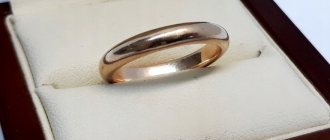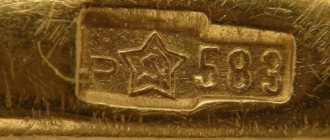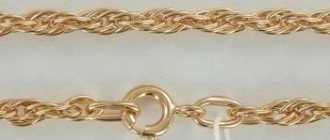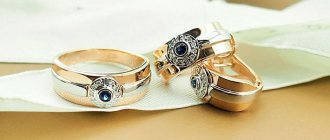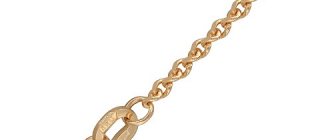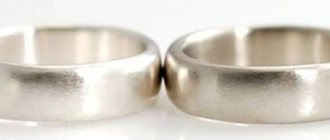A chain is the most versatile and functional product, which, thanks to the skill of specialists, has become a full-fledged piece of jewelry. It is worn as an independent accessory, complemented with a pendant, a body icon or a cross.
Now jewelry manufacturers offer us a huge number of chains: short and elongated, wide and narrow, classic and decorative, men's and women's, gold and silver, not to mention dozens of different types of weaving. How to choose a chain that is right for you? We invite you to figure this out together.
Chain weaving technologies
Chains are made in several ways - by hand, machine knitting or stamping.
Machine weaving is an automated technology using special equipment. The use of machines allows you to create jewelry with links up to 0.2 mm thick.
Despite the latest technologies, some types of weaving can only be done by hand. And here you can’t do without specialists—chain tyers. The minimum weight of a hand-woven chain is about 6 grams, and its quality largely depends on the skill of the jeweler.
This is really painstaking and time-consuming work. First you need to stretch the gold or silver wire, wind it on the prepared base and cut the resulting spiral into rings of the same size. The chain maker manually fastens the links using pliers, “linking” the pattern, which involves the type of weaving. To prevent the rings from falling apart, all the links are soldered. The resulting chain is clamped between special shafts so that the links become flat.

Stamped chains are made from ready-made links - stamps. At the same time, they are not soldered together, but threaded into each other. As a rule, such jewelry is less durable, easily twisted and deformed.
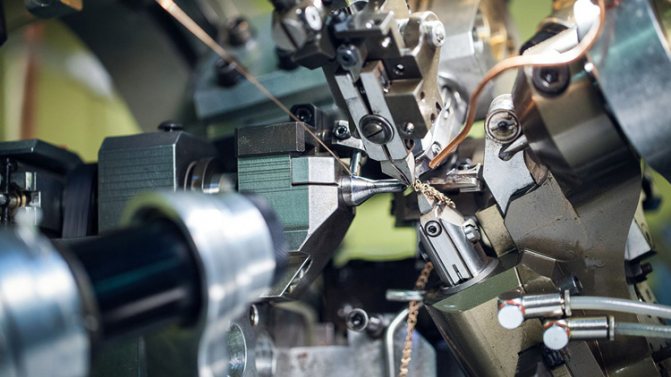
Production technologies
Jewelry factories use three methods of producing chains: hand weaving, machine knitting and stamping.
The first technology is used to create exclusive jewelry with complex weaving. Chain makers have outstanding metalworking skills. Craftsmen independently produce wire from gold or silver. The workpiece is wound onto a base and cut. The resulting rings serve as the basis for the links from which the chain pattern is formed. Soldering of each element is done manually. The final stage of the work is rolling the jewelry through special shafts that make each link flat.
Machine weaving is performed on automated lines, which are equipped with high-precision equipment. Programmable machines are capable of creating miniature elements whose thickness does not exceed 0.2 mm.
Stamping allows you to produce chains from ready-made links, called dies. The technology makes it possible to do without soldering: the individual components are threaded into each other.
Solid or hollow: what's the difference?
All chains, regardless of the type of weaving, are divided into solid and hollow.
A distinctive feature of hollow chains is the combination of volume and lightness. The wire from which the decoration is woven is hollow inside, so despite the external thickness of the links, hollow chains have little weight. Most often they are made using complex decorative types of weaving and look quite solid. The advantage of such chains is their affordable price, which is determined by the weight of the product.
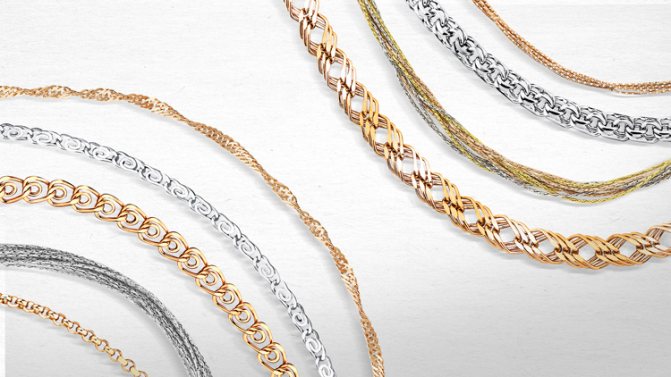
Solid chains are much heavier than hollow ones, which affects the cost of the jewelry. However, they are very comfortable for everyday wear, resistant to deformation and external influences and therefore durable. If the links are damaged, a specialist can easily solder the product and restore its original appearance.
Features of solid and hollow links
Jewelry woven using different technologies can be hollow or solid.
Hollow links are created from hollow wire, which gives the decoration the necessary volume while maintaining light weight. Often accessories of this type are made using complex weaving techniques and are complemented by a large number of decorative elements. The advantages of hollow chains are low cost and solid appearance.
Jewelry made from solid links has more weight. A significant amount of gold or silver is used in their manufacture. Chains of this type are resistant to deformation and are significantly stronger than their hollow counterparts. Damaged links can be repaired in a jewelry workshop - a specialist will solder the broken elements.
Types of chain weaving
There are three basic technologies for knitting chains: “Anchor”, “Pantsirnaya” and “Bismarck”. Over time, they received so many variations that today there are more than 50 types of weaving: from the simplest to the most intricate with links of a complex configuration. Each weave has a special name and can be made in either gold or silver.

It’s easy to guess that “Anchor” weaving got its name due to its resemblance to the weaving of a real anchor chain. It is simple and uncomplicated. In the classic version of weaving, each link has an oval shape.
Links can consist of either one or two “rings”. Therefore, the “Double Anchor” technology is also distinguished.
An "anchor" weave with round shaped links is known as "Rollo". At one time, this type of knitting became popular thanks to the fashion house Chopard, so it has a second name - “Chopard”.
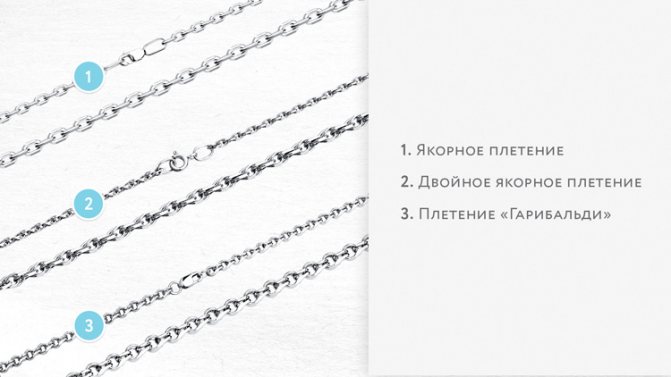
The Garibaldi weave is very similar to Rollo. The links of these chains have a round forked shape. It is believed that the knitting was named in honor of the spouses Giuseppe and Anita Garibaldi - folk heroes of the liberation movement of Italy, who were very friendly and shared each other’s views.
Fantasy types of “Anchor” weaving also include “Aurora” and “Hawaiian”.
“Shell” technology has become the basis for creating various types of decorative weaving. Its distinctive feature is that the flat links, polished on both sides, are not attached perpendicular to each other, but as if in the same plane. The technology, characterized by its high strength, got its name due to its resemblance to chain mail links.
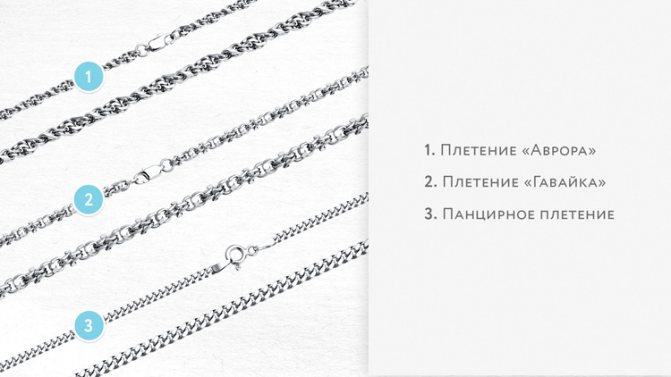
Weaving can be single, double or triple, depending on the number of rings connected. A “shell” knit with diamond-shaped links is called “Diamond” (it can also be double or triple).
“Nonna” is one of the most elegant varieties of armor weaving. Thanks to the diamond edge applied on both sides, such chains shine more in the light. Despite the external sophistication, these jewelry are very durable. Oddly enough, the name of the weave has nothing to do with the woman's name. Nonna is short for the Italian maglia della nonna, which means "grandmother's weave."

An equally spectacular variety of armor knitting is “Figaro”, named after the famous comedy hero Beaumarchais, who was distinguished by his changeable temperament. Just like Figaro, weaving is characterized by “inconstancy” - links of different shapes, short and long, alternate in the chain. The most common combinations are from 1:1 to 1:5. Figaro chains gained popularity thanks to the jewelry house Cartier, and gradually became known as “Cartier”.
Often chains get their names due to the special shape of the links. Thus, the “rings” resembling hearts gave the name to the romantic and delicate weaving “Love”. Thanks to the links twisted into a spiral, the “Snail” weave appeared (it is also called “Paperclip” for the similarity of the “rings” with the stationery of the same name), and the divisions, similar to a beautiful flower, gave the name to the “Rose” chain.
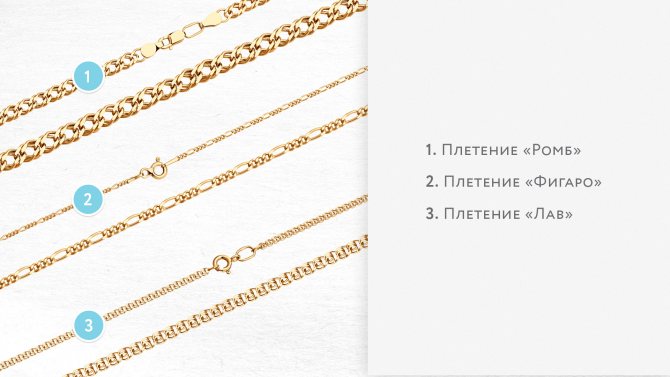
A smooth, snake-like jewelry cord with tightly fitting links is known as a “Snake.” This weaving is comfortable for everyday wear, so it is often used not only in the manufacture of chains, but also bracelets for pendants and charms.
The most popular twisted weaves are the rope-like “Korda” and the “Singapore” shimmering in the sun. Such chains are usually worn by women. These decorations are elegant and at the same time reliable in use.

But “Bismarck” is considered a truly masculine type of weaving in Russia. Named, according to one version, in honor of the first Chancellor of the German Empire, Otto von Bismarck, he is also known as the “Kaiser” or “Cardinal”. This weaving is one of the most complex and is therefore often done by hand. Fantasy knitting consists of links, which in turn consist of several multidirectional “rings”. The weave can be double, triple or quadruple, making it one of the strongest. Due to its thickness and volume, one of the varieties of “Bismarck” was called “Python”.
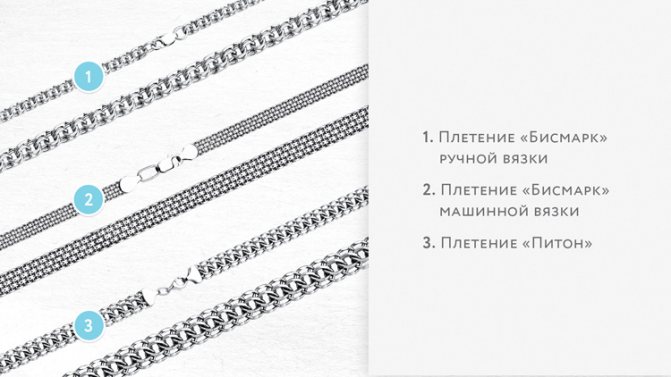
An undeniable trend is the so-called fantasy chains. These decorations are distinguished by unusual types of weaving, a combination of different shades of metals, multi-layering and the inclusion of decorative “links”. Fantasy chains are more reminiscent of a necklace or beads and are a completely independent decoration that can be worn without a pendant.

Varieties of chain weaving
The variety of chains allows us to satisfy the countless requirements of potential buyers. Heavy and light, standard and designer, men's, women's, unisex, inexpensive, priceless - there is sure to be a copy for every taste and budget. All products differ in their weaving characteristics.
The classic option is anchor weaving, the simplest and most durable. Chain links are round or elongated. It can take the form of a flat tape or a real anchor chain. Men like such chains because of their massiveness and laconic design. They can easily withstand massive pendants and crosses hung on them.
It is reminiscent of Venetian anchor weave, although the links are larger and have a square or rectangular shape.
The Tondo type of chains is popular among women. A special continuous weave is formed by a round cord formed by links tightly adjacent to each other. They resemble snakeskin scales. Tondo weaving is very durable and is based on a double shell joint. The chain turns out elegant, the polished scales shimmer effectively when moving. Small pendants look great with this chain. It is better to remove the jewelry at night to avoid creases.
The products of flat armor weave attract attention. It is distinguished by thin plates soldered onto chain links. In appearance they resemble segments of a turtle shell. But they are the ones who create problems when worn, clinging to clothes.
Among the most popular is the Bismarck weaving chain, which has many options:
• Cardinal - complex massive weaving, done only by hand; • Stream – rounded links create the effect of a smooth flow of one into another; • Python – rounded links form a three-row tape; • Byzantium – this weaving is designed to create high-priced designer jewelry.
Nonna lace weaving is made from a two- or three-row connection of oblong segments. The strength of the chain is provided by large links, inside of which there are smaller ones. The surface of the links is usually plated with rhodium, which gives the product an airy feel.
Perlina is considered separately in the list of types of chain weaving. This chain looks more like a stacked necklace. Its links look like hollow balls and are simply strung on a thread. In this case, you can form either a flat tape or a twisted one.
Fans of large jewelry turn their attention to inflated chains and bracelets. For all their bulkiness, they are light due to their internal hollowness. The process of their production is extremely original.
To achieve the hollow effect, a core of inexpensive metal is used during molding. The link formed from the core is wrapped in a plate of gold or silver. Using a special technology, the core melts and flows out, leaving a precious shell.
A chain of hollow elements is quite strong, but if the links are damaged it is impossible to restore. The weight of a pendant on an inflated chain should be no more than 30 percent of its mass.
Which weave to choose?
Of course, first of all it is a matter of taste. However, some types of chains are traditionally classified as women's, men's or universal. Thus, the massive and solid “Bismarck” is most often preferred by representatives of the stronger sex, and the graceful “Nonna”, “Singapore”, “Rose”, “Love” and a number of other varieties are considered truly feminine. A typical unisex weaving option is “Anchor”.
For children, the most optimal are densely knitted chains, for example, “Snake”, as well as jewelry cords made of rubber or leather.
Choosing the chain length
One of the important criteria when choosing a chain is its length. As a rule, the size range consists of models from 40 to 70 cm.
- 40 cm - the chain is worn close to the neck
- 50 cm - the chain is worn at the level of the upper part of the neckline
- 60 cm - the chain is worn at the level of the middle part of the neckline
- 70 cm - the chain is worn at the level of the lower part of the neckline
It is believed that it is better for women to choose chains up to 50 cm, and for men - longer. Still, there are exceptions to every rule, and when purchasing jewelry, you must try it on.
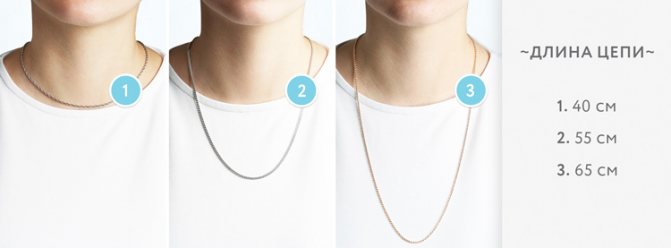
Types of chain locks
When purchasing a jewelry chain, pay attention to its lock. Firstly, it must be of high quality, since the safety of the jewelry depends on this “minor” detail. And secondly, the lock should be comfortable so that you can fasten and unfasten it yourself, easily putting any pendants on the chain.
As a rule, the type of lock is selected by the jeweler depending on the weight and type of weaving of the item. More massive chains have reliable carabiners, while elegant, thin models are more suitable for a spring lock. Most often, both types of fasteners allow you to easily put pendants with different eye thicknesses on a chain, so they are approximately equivalent to each other in terms of convenience and reliability.

Manufacturing technology
All chains, depending on the production method, are divided into: handmade and machine knitted. Made by hand, they are of much higher quality. Let's look at the common varieties, starting with the most reliable.
Carapace
This weaving can be confidently ranked first in terms of strength. Unique beauty is achieved through large links with large flat surfaces, which gives a unique mirror-like shine, especially on massive samples. The disadvantage is a fairly rapid loss of shine, due to the fact that gold is a soft metal and is easily scratched.
Anchor
Weaving resembles a ship's chain; this is often its second name. It is very modest in appearance, suitable for those who love minimalism, but in terms of strength, such products are practically not inferior to armored weaving. Samples weighing 10 grams or more can last a very long time. The chain is universal - suitable for both men and women. Properly filed edges are the main indicator of good workmanship.
Bismarck
Probably the most popular type of weaving, this is due to its versatility, the ability to produce almost any weight, from 5 g to any desired weight, and ease of production. It has good durability; chains from 15 g can be worn for the rest of your life. The disadvantage is the lack of exclusivity; many of our fellow citizens wear such jewelry. The sample shown in the photo weighs approximately 150 grams in gold.
- This is useful: Varieties of Bismarck chain weaving
Cardinal, python (Italian)
Of all the above weavings, this is the weakest; thinner wire is used for its production. However, it can probably be considered the most beautiful, voluminous and delicate, therefore it is more popular among the fair half of humanity. For men, there is a version with springs at the joints of the links. Such chains have an original appearance, but the complexity of manufacturing makes the cost of work high, and the minimum weight is also limited (from 40 g). But they have increased strength.
Unlike handmade, machine-knitted chains cannot boast of good reliability indicators. The main reason is the small mass of products made in this way.
Combination of chain with bracelet and pendant
Many of us wear a chain all the time, so we don’t perceive it as decoration. However, we should not forget that this is an accessory that, like any piece of jewelry, requires special combination rules.
The pendant should match the chain in size, weight (about twice as light) and metal color. Thus, a large pendant or cross on a thin chain will look ridiculous, and at the same time, a pendant that is too small will not fit on a massive item.

Be sure to check that the ear of the pendant fits freely through the lock.
In addition to ordinary chains, there are also chain bracelets that are often worn by both women and men. Ideally, the types of weaving of both products should match, but this does not happen often - jewelry can be given as a gift, purchased in different places, or several years apart. Therefore, it is enough that the bracelet and chain match each other in thickness and metal. For example, the “Nonna” chain will look good with a “Rhombus” or “Love” weave bracelet, and the “Bismarck” chain will look good with a wide “Armor” knit.

In any case, if you doubt the compatibility of two decorations, it is better to leave one. As the incomparable Coco Chanel said, “When choosing accessories, take off the last thing you put on.”
